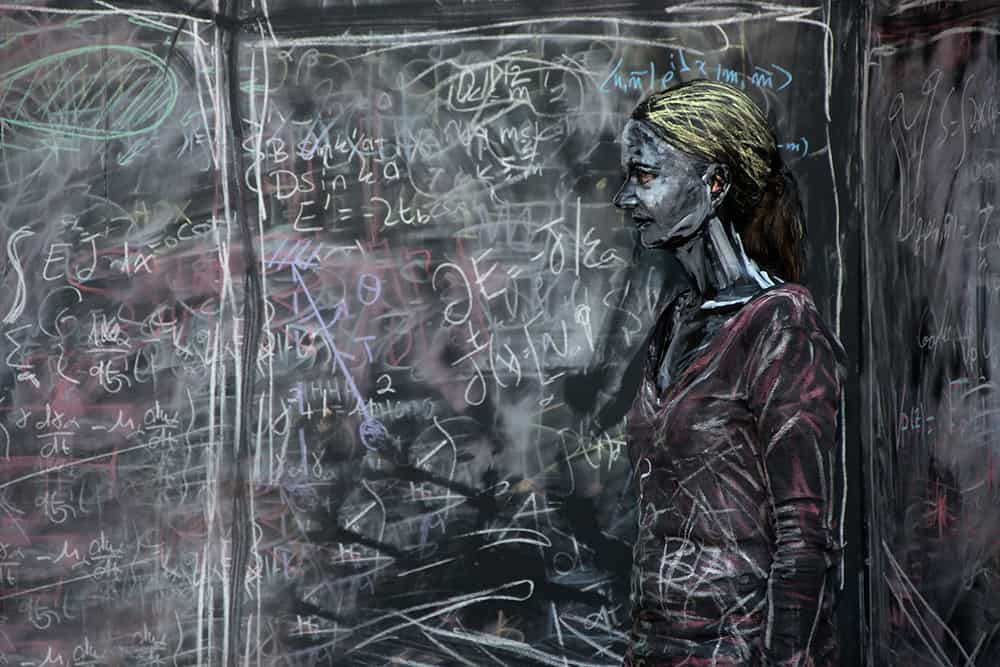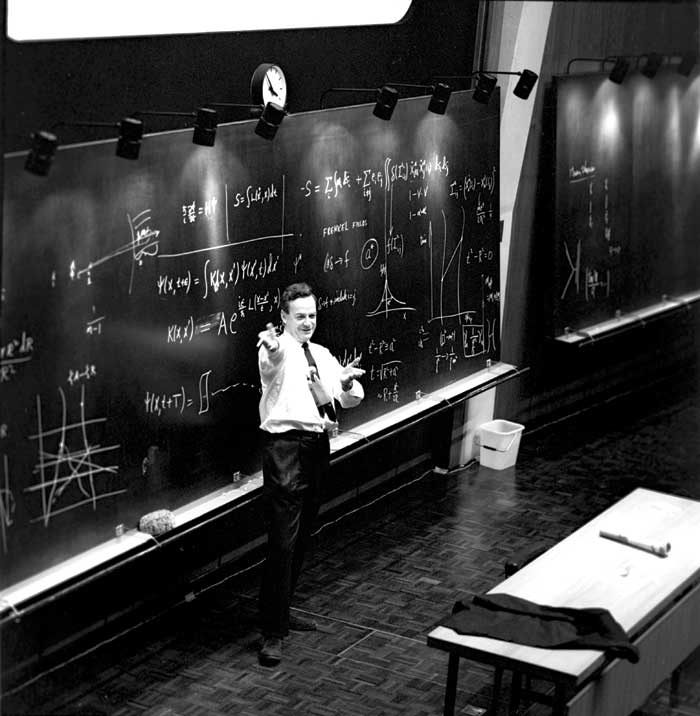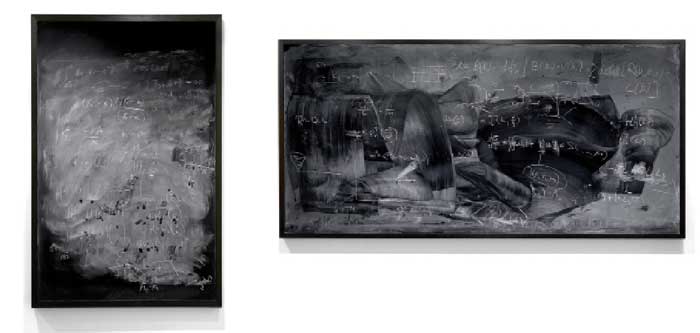Despite us living in an era of PowerPoint, smartboards and digital projection, the traditional blackboard still retains an aura and usefulness for physicists that more advanced technologies can’t match, as Philip Ball finds
He’s a photogenic sort of guy, of course: that puckish smile, the twinkling eyes, the exuberant mane of hair. But what is most noticeable is that Feynman is often standing in front of a blackboard – usually adorned with squiggles that most physicists will identify as the notation of quantum mechanics.
While looking through images of famous physicists for a forthcoming book on quantum theory, I was struck by how often the blackboard is their backdrop. From Albert Einstein and Niels Bohr to Werner Heisenberg and Paul Dirac, all have their “blackboard portrait”. Sure, experimentalists are usually depicted surrounded by lab equipment, but it seems we have decided nothing announces “theoretical physicist” as clearly as the blackboard. What’s going on?

Teaching tool
The profession-defining pose is an old idea. Back in the 19th and early 20th centuries, chemists – from Louis Pasteur to Marie Curie – were commonly photographed or painted holding aloft a flask and gazing nobly at its contents. It was a gesture that actually derives from a rather unheroic tradition: physicians in the late Middle Ages and the Renaissance would typically be depicted diagnosing their patients by a visual inspection of their urine.
Physics is a younger discipline, barely recognized in today’s sense until the 19th century. And theoretical physics is more recent still – Einstein’s generation was the first to make it a distinct endeavour. But by choosing the blackboard pose as the archetypal image of the physicist, we seem to be saying that physics is inherently cerebral, defined by abstract mathematical ideas inscribed in chalk.
That conception probably owes a great deal to Einstein himself. As the French literary theorist Roland Barthes explained in 1957: “The historic equation E = mc2, by its unexpected simplicity, almost embodies the pure idea of the key…opening with a wholly magical ease a door which had resisted the desperate efforts of centuries.” And popular imagery, Barthes continued, faithfully expressed that idea. “Photographs of Einstein,” he wrote, “show him standing next to a blackboard covered with mathematical signs of obvious complexity; but cartoons of Einstein…show him chalk still in hand, and having just written on an empty blackboard, as if without preparation, the magic formula of the world.”
The evocative power of the equation as a “magic formula”, as if it is some gnostic incantation to unlock the secrets of the universe, is an image with roots in the Renaissance tradition of natural magic. But why should writing it on a blackboard make it so potent?
Black to basics
The invention of the blackboard is popularly attributed to a Scottish schoolteacher named James Pillans, who early in the 19th century placed many slate tablets side by side so that the old practice of writing on them with chalk could convey more complex information and illustration. But these writing devices might be much older. “I have heard that blackboards originated in India”, says theoretical physicist Harsh Mathur of Case Western Reserve University in Cleveland, Ohio, who adds that the famous Persian traveller Al-Biruni wrote about their use in the 11th century.
Whatever their origin, by the mid-1800s these boards were made instead from wood coated with a thick black paint, which could be wiped clean with dry rags or felt erasers. And while the appeal of a cheap, erasable surface for displaying large words and diagrams in high-contrast markings might not seem particularly mysterious, anyone who has ever used a blackboard and chalk knows there is more to it than that.

Make an error in your spelling or calculation and – swish! – it’s gone, as if you’d never made the slip at all. There are no electronics to malfunction or bulbs to burn out, as was often the case with the overhead projectors that once sought to usurp the blackboard’s role. It’s easy to edit the surface, leaving parts of what you’ve written while erasing others. And there’s no more satisfying way of starting afresh on a problem than wiping your earlier thoughts with a damp cloth to return to that light-absorbing void.
Sure, whiteboards don’t cloud you in dust, but nor do they capture the same aesthetic. Perhaps, given the white or pale walls of most academic environments, whiteboards don’t sufficiently demarcate a space for thinking from the distractions of the surroundings. Besides, the pens smell and dry up, they slip and slide on the shiny surface, and they’re easily smudged. Worse, you can never quite get the damned boards clean: there’s always a faint residue, the distracting whisper of someone else’s ideas.
Blackboard and chalk – like paper and ink – are a combination that modern technologies can’t improve or displace. You still see blackboards (and plenty of whiteboards too, it’s true) in physics research centres across the world. At the Perimeter Institute for Theoretical Physics in Waterloo, Canada, they’re an essential element of the design, being installed in the lifts and coffee areas of the original building. The Isaac Newton Institute for Mathematical Sciences in Cambridge, UK, even has blackboards in the toilets; you never know when insight might strike.
This ubiquity can create a sense of community and shared endeavour, as if the creative thoughts of one’s peers seep into the very walls. “The evidence of past conversations can be inspiring”, says Lauren Hayward Sierens, a condensed-matter physicist at the Perimeter Institute. “Often what you’ll see on a given blackboard at the Perimeter is a combination of many different conversations. I can rarely understand these past conversations if I wasn’t a part of them, but it’s inspiring nonetheless to be surrounded by so many ideas.”
Chalk and talk
For Seyda Ipek, a particle physicist at Fermilab, blackboards are such a part of her everyday life that talking about them is like discussing how one drinks water. “You don’t think about it until it is pointed out,” she says. “At Fermilab both offices and common areas are filled with blackboards and whiteboards. My previous institution, the University of Washington, also had blackboards everywhere, including hallways.”
Ipek says that these surfaces promote informal, impromptu communication and discussion. “We have a whiteboard in our coffee lounge. While we have our after-lunch coffee, we often use it. Someone asks ‘What’s new?’ and then someone else goes up to the board and says ‘I’ve been thinking about this lately. Let me show you.’”
Quite simply, the blackboard is a democratic space, where ideas can be easily shared. “Two people can’t bend over a notebook to discuss,” Ipek points out. “The board gives ample space and it is generally understood that anyone can go up to the board. Sometimes people do that to clarify their misunderstandings, or to challenge each other. Duelling with ideas at the blackboard is not uncommon.”
That kind of intellectual sparring might be hugely facilitated by this shared canvas for thinking on. If someone claims your idea is wrong, you might feel attacked and respond defensively. But if your ideas are chalked on a board, you and your colleagues can scrutinize them almost as an impersonal object of study. Over at Case Western, Mathur believes that the ease of erasure makes students less hesitant to put down answers on the board. “Perhaps it’s the impermanence of writing on a board that makes them feel less concerned about being judged negatively,” he says.
Using a blackboard also moderates the pace of a discussion or explanation. Blackboards help in teaching by slowing down the lecture and allowing the students to absorb information and knowledge at a more human rate. Students in Mathur’s first-year introductory physics class overwhelmingly favour the blackboard over PowerPoint as the primary means of communication.
The time and effort involved in using a blackboard can be good discipline for communication too. PowerPoint speakers who flash up slide after equation-packed slide would have to speak more slowly and think twice about what to include if forced to write everything out by hand. Blackboards, Ipek notes, regulate one’s talking speed and give the audience time to absorb the ideas and ask questions. “At Fermilab we have a journal club where each week one person gives a blackboard summary of an interesting paper. One week we had a talk with slides, and everyone complained.”
There’s also something about a blackboard that seems to fit with the way the mind works: sketching, erasing, supporting a free flow of ideas. “Many physicists like to do a back-of-the-envelope calculation before delving deeper into a computation, and blackboards are a great tool for that”, says Tibra Ali, another theorist at the Perimeter Institute. Indeed, there’s a trophy-like quality to a clever piece of work prominently displayed on a blackboard. Some physicists like transcribing a hard-won solution onto a blackboard to understand the full ramifications – and perhaps just to gloat.

If it ain’t broke…
Despite their low-tech nature, blackboards seem to be working together with new technologies. Ali, for example, says that he and his collaborator often do computations on a blackboard and take an image of them with their mobile phones before erasing the writing and moving on to the next step. “Many a time,” Ali says, “the main idea or the main computation for a project that becomes a paper happens while we are doing these intense computations on a blackboard.”
Given that the blackboard appears to be an optimized technology, tampering with it might seem to be a bad idea. Designers of the new Stephen Hawking wing of the Perimeter Institute thought they knew better, installing a special glass in the discussion areas when it opened in 2011. Opaque but bright when viewed from the front, the glass becomes transparent from the side. “The idea was to have an open bright space with natural light but at the same time have the glass serve as whiteboards on which physicists can write with markers,” recalls Ali.
But the physicists didn’t bite – and eventually old-fashioned blackboards were placed in those discussion areas instead. Likewise, when shiny PVC blackboards, requiring special pens, were installed at the National Graphene Institute at the University of Manchester, UK, to eliminate “dangerous” chalk dust, they were barely used. Squiggles written on a visit by then British chancellor George Osborne were later accidentally wiped by an over-eager cleaner.
There are, then, plenty of practical reasons why blackboards are great tools for thinking, collaborating and communicating. But as Barthes hinted, their significance for physics goes beyond the pragmatic. Displayed at epic scale on walls, blackboards can’t help but exude power, authority and even artistry. With their imperfectly erased ghosts of equations past, they remind us of medieval palimpsests: documents on vellum that, too expensive to discard, were scraped almost clean for reuse while still carrying the tantalizing traces of other thoughts in other minds.
Like historical relics and works of art, blackboards may themselves become venerated objects, imbued with almost mystical significance. The blackboard used by Einstein when he gave three lectures on general relativity at the University of Oxford in 1931 has been preserved as a historical artefact at the Museum of the History of Science in Oxford. (There used to be two blackboards, but one disappeared “in mysterious circumstances”, according to former museum director Jim Bennett.) The board shows Einstein’s calculations of the age, size and density of the universe, and it has become the most famous object in the collection. “People come to the door of the museum and say ‘Where is Einstein’s blackboard?’,” says Bennett. “It’s become a sort of icon. People come and look at it as if is was almost a sort of quasi-religious object.”
We do that to other historical artefacts of science too, of course – Michael Faraday’s induction coils, Galileo’s wooden ramps, a first edition of Isaac Newton’s Principia. But a blackboard used by a legendary scientist has a unique aura, not just because the equations and diagrams were traced in perilously fragile chalk dust by their own hand but also because these markings seem like a trace of thought itself. Like thoughts, they can be fleeting, they can vanish at the stroke of a hand. Yet here they remain: the magic formulae of the world.
Feynman’s blackboard at the California Institute of Technology was photographed at the time of his death in 1988, and seems almost tailored to serve as an epitaph for the great scientist. “What I cannot create I do not understand,” he had written – followed by what might be seen as a corollary: “Know how to solve every problem that has been solved.” Feynman might just as well have written these thoughts in his notebook. But how much more mystique and pathos they acquire on a blackboard.
The art of the blackboard

It was the allusive quality of semi-erased blackboards that appealed to Alejandro Guijarro, a Spanish artist who has taken a series of photographs of physics blackboards that he found in lecture halls and researchers’ offices at CERN, and university institutes in Oxford, Cambridge (UK), Stanford and Berkeley. These images, Guijarro has explained, “are fragmented pieces of ideas, thoughts or explanations from which arises a level of randomness”. He admits that he didn’t understand any of the physics but selected the blackboards purely on aesthetic grounds. “I was interested in the action, the gestures and the marks on the surface” – which he looked at as one might the brushstrokes in an abstract painting.
Given their size and their public nature, blackboards can become almost a “performance space” for the physicist. The performative human traces left in blackboard inscriptions were the subject of an art installation commissioned by Canada’s Perimeter Institute for Theoretical Physics in 2015. Artist-in-residence Alexa Meade created a “room” that was one gigantic blackboard, in which not only its walls and armchairs but also two live researchers became the dark surfaces covered with inscribed lines and symbols and the expressionist smears of erased chalk. Meade made her blackboard “universe” after first immersing herself in the culture of the institute, attending lectures and talking to the scientists.
“I think Alexa’s work captured the fundamental connection between the blackboard and the theoretical physicist, illustrating how the blackboard allows a physicist to put his or her thoughts and ideas into a new form,” says Lauren Hayward Sierens, who was one of two Perimeter scientists enlisted by Meade as a human blackboard. It’s hard to imagine whiteboards having quite the same visual appeal for artists.
- Watch artist Alexa Meade create The Living Chalkboard with Perimeter Institute physicists. For more about this project, see the Perimeter Institute website. (Video courtesy: Alexa Meade/Perimeter Institute)




